This from Tim Olk:
On Sat July 23,2016, Chicago Fire Department Tower Ladder 10 was sent to a high-rise on north Halsted for a report of four people stuck in an elevator. After trying to reset the elevator failed, they requested a blind shaft response.
Companies were:
Batt 3
Tower 10
Squad 1
Squad 2
Special Operations Chief 515
and an ambulance
The car was stuck between floors 2&3. Firefighters locked out the elevator and setup on the 5th floor with ropes and worked off floor 4. After lowering a firefighter down the shaft, they found four girls who had been in there for two hours but were in good spirits. Firefighters brought them to the 4th floor by rope where they were evaluated by paramedics.
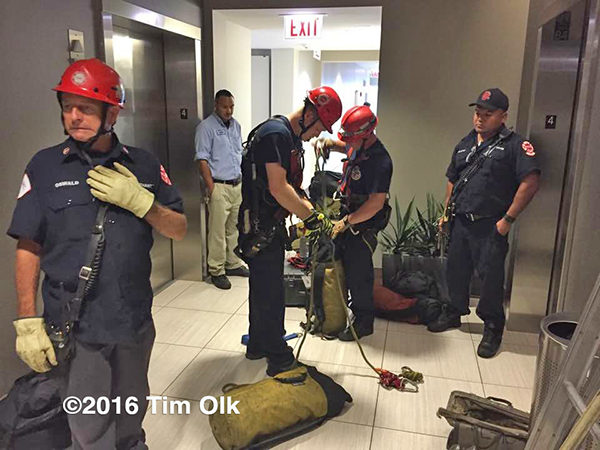
Tim Olk photo
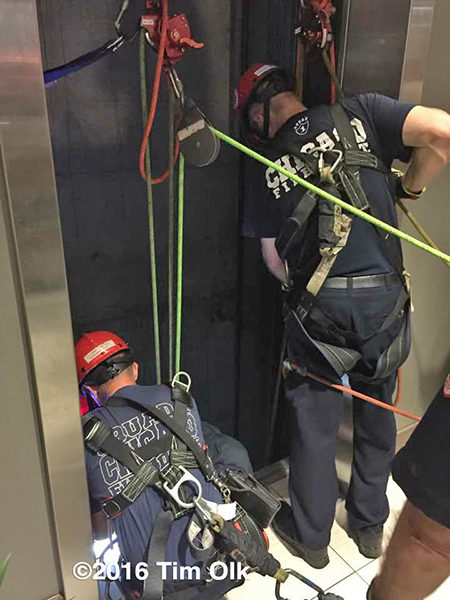
Tim Olk photo
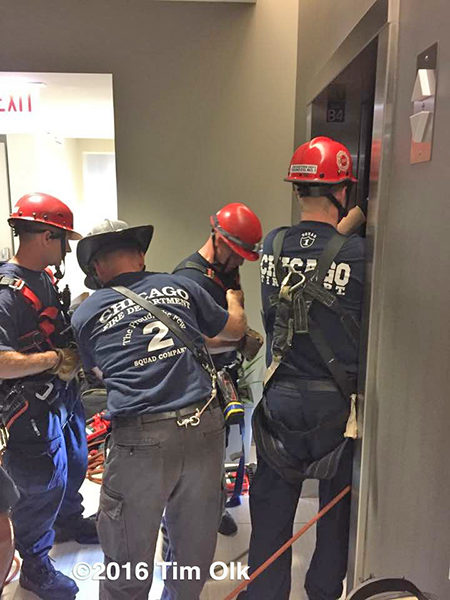
Tim Olk photo
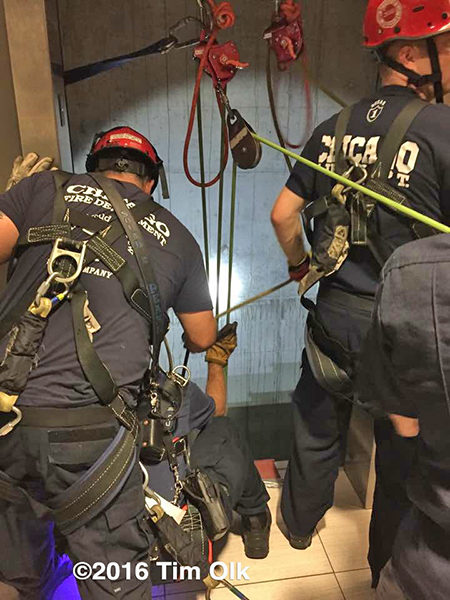
Tim Olk photo
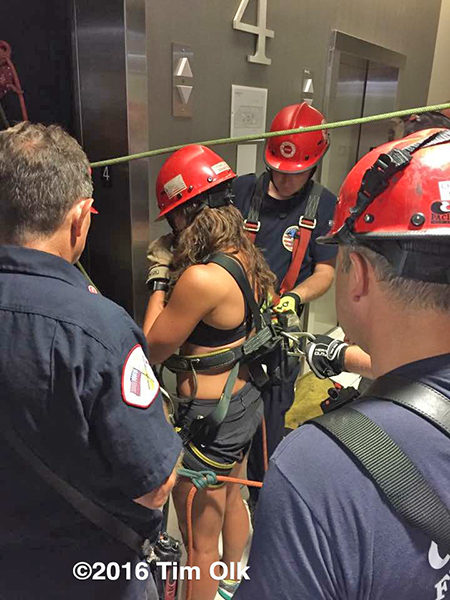
Tim Olk photo
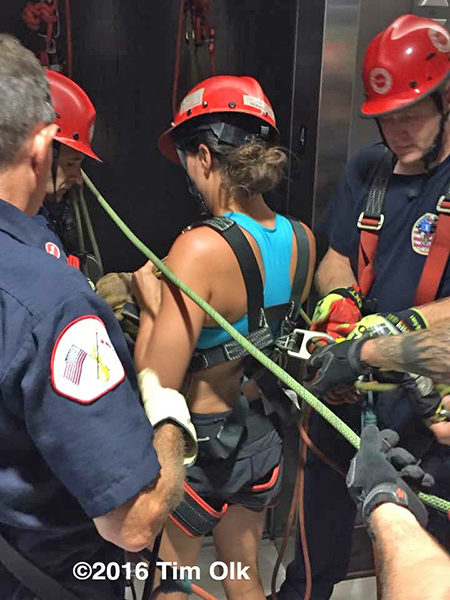
Tim Olk photo
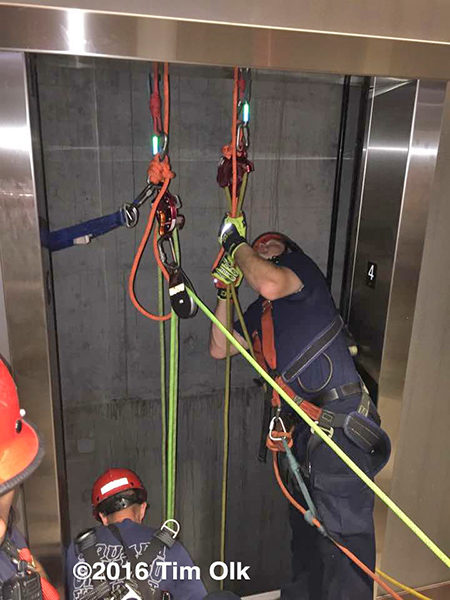
Tim Olk photo
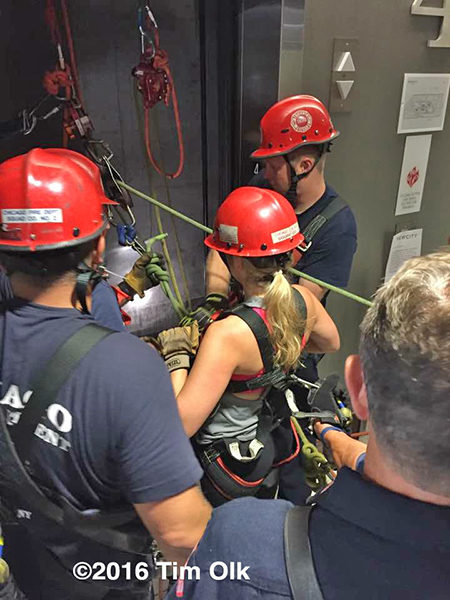
Tim Olk photo
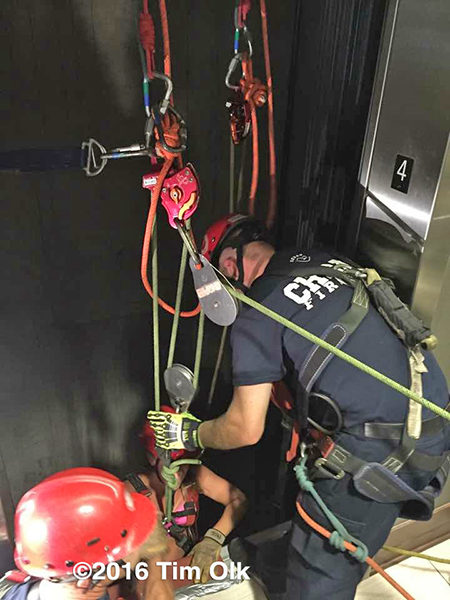
Tim Olk photo
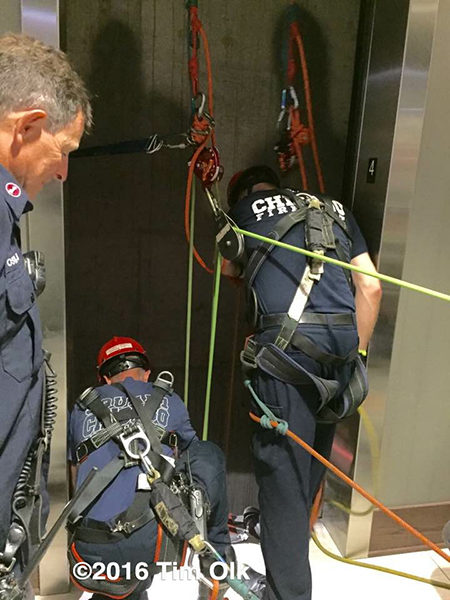
Tim Olk photo
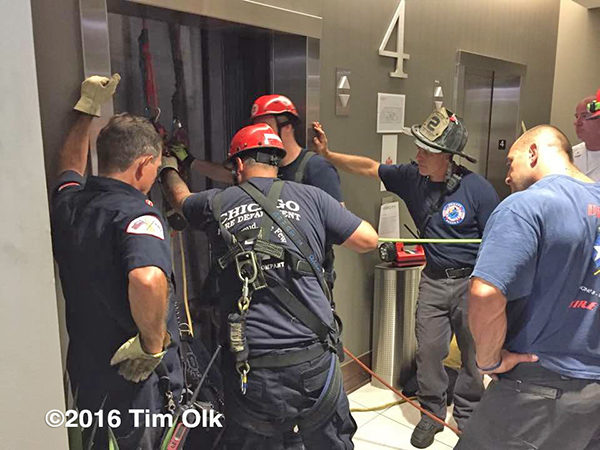
Tim Olk photo






























#1 by Bill Post on July 29, 2016 - 11:35 AM
Fred M ,even though the Flying Squads were created to primarily back up the Engine and Truck companies that had 4 men assigned to them they were supposed have Squad type of equipment on them so they could function as “Heavy Rescues “when needed”. As previously mentioned the 1968 Maatman report that initially recommended that they go in service had also recommended that all of the 3 Snorkel Squads (at the) time be taken out of service, however it also recommended that Salvage Squad 1 remain in service as the “downtown” or Central City Salvage and Rescue type Squad. Salvage Squad 2 and Squads 4 and 9 which were the remaining Squad companies left in service were also recommended to be taken out of service.
By the time the report was released 5 addition Salvage Squads were created in October of 1968 with one Salvage Squad assigned to each of the 7 (at the time) Fire Divisions. Squads 4 and 9 were converted to Salvage Squad 3 and 7 and 3 additional Salvage Squads were also put in service.
The 6 original Flying Squads were put in service in early and mid 1969. The irony about that is Salvage Squad 1 was taken out of service when Flying Squad 4 was put in service ,in fact Flying Squad 4’s first rig was Salvage Squad 1’s 1954 Auto Car. That didn’t last very long however and Flying Squad 4 as well as the other 5 Flying Squads were assigned old late 40’s and 1950’s vintage “spare” pumpers. The 6 remaining Salvage Squads stayed in service however.
The only Flying Squad that had a “specialty” was Flying Squad 4 as when they were put in service or shortly after they had become Chicago’s “bomb and explosive device” Squad and they men assigned to Flying Squad 4 were trained as explosive device dismantling technicians and yes they responded around the city on bomb scares using their regularly assigned “old pumper”. That function of “bomb squad” was not recommended in the Maatman report either. Fortunately within a year or two a relatively small van was put in service as an explosive technician truck and a special trailer was also purchased which had a lead line compartment or cubicle for safely transporting suspicious devices and explosives. The special “bomb squad” vehicle was located at Engiine 42’s house for a short period of time and Flying Squad 4 ceased functioning as Chicago’s “Bomb Squad”. Finally the Fire Departments Bomb Squad vehicle was turned over to the police department which is where (in my opinion) they should have been put in service to begin with. In the vast majority of places the police departments as well as the military run the “Bomb Squads”. From 1969 until 1973 the Flying Squads functioned strictly as manpower companies with the temporary exception of Flying Squad 4 of course. Flying Squad 4 located at Engine 28’s house at the time. The Flying Squads were equipped with SCBA’s for their 6 man crews and they also had K-12 power saws. As they were using old pumpers their driver was a regularly assigned Engineer and they were equipped with a very limited amount of hose.
In 1971 a follow up Maatman (consultant) report was released and had amongst other things recommended that a 7th Flying Manpower Squad be created. The reason for that recommendation is that in the 1968 study Flying Manpower Squad 5 had been recommended to be put in service at Engine 7 and Truck 58’s station so as to cover the Northwest side of Chicago. When Flying Squad 5 was put in service in 1969 it was located at Engine 114’s former station instead which was located on Fullerton east of Central Park which was not a good location to cover the far northwest side from because it was too far south and too far east. From that location Flying Squad 5’s district had included Engine 119 and Truck 55’s area and it running district went to the city limits as far as the Howard street west of Harlem area which was on the border of Chicago, Niles and Park Ridge. Flying Squad 6 was the only other Flying Squad that was located on the northside and the running district borderline between Flying Squad 5 and 6 for the far northwest side was Elston avenue north of Irving Park and Montrose . Flying Squad 6 was located at Engine 128’s former Station at Eastwood and Seeley. at the time. To rectify that situation the 1971 Maatman report had recommended that the new Flyiing Manpower Squad 7 be put in service at Engines 108’s house, where the Far Northwest side could be adequately covered from. The
The 1971 Maatman study was also more specific as to the design of the vehicles that the Flying Squads should be operating with as well as the equipment that they should be carrying on the Squads. On November 16 1971 Salvage Squads 6 and 7 as well as Trucks 43 and 46 were taken out of service. Flying Manpower Squad 7 was also created on that day. Flying Squad 7 was put in service using Salvage Squad 6’s old 1953 FWD (Four Wheel Drive) pumper. Truck 43 had been located with Engine 110 at 2322 W Foster and Truck 46 had been located with Engine company 67 and the old 23rd Battalion at 4666 W Fulton street (near Cicero and Lake streets). Snorkel 6 and Flying Squad 6 eventually moved into Engine 110’s quarters.
Snorkel 4 and Salvage Squad 2 had moved into Engine 67’s quarters.
Two years later in early 1973 new Mack/Platt Squad (box style) Trucks were put in service on all 7 Flying Manpower Squads. By then the 4 remaining Salvage Squads were out of service. The New Flying Squad trucks were equipped with Hurst tools and other Squad type of equipment and even though they continued responding with the 4 man Engines and Trucks on still alarms they would respond beyond their still districts if necessary on “Pin In” accidents and other Rescue type of runs.. Before the new Squads trucks were put in service Snorkel Squad 1 was the only company that was equipped with a Hurst Tool on it. The Hurst tools (Hydraulic Spreaders) were first used in the early 70s so Snorkel Squad 1 had one only about a year or two before they were given to the Flying Manpower Squads as well. Snorkel Squad 1 may still have carried more equipment on it then the Flying Squads but beginning in 1973 the Flying Squads also took on the functions of a Heavy Rescue company.
During mid 1980 (several months after the strike) Flying Squads 1 and 7 were taken out of service as well as Snorkel Squad 1 (during October) and the 5 remaining Flying Manpower Squads were converted into regular Squad companies with one assigned to each of the 5 new fire districts (at the time). Several Truck companies also were given Hurst Tools to make up for the reduction of 3 of the Squads.Some of the trucks located near the expressways and on the far ends of the city were given Hurst tools so they wouldn’t always have to wait for the arrival of a Squad to be able to use them.
#2 by Bill Post on July 28, 2016 - 11:48 PM
Fred M.the Flying Squads were meant to be both manpower back up for the 4 man engine and truck companies and also supposed to be heavy rescue style squad companies. As I previously mentioned the 1968 Maatman report recommended that all three (at the time) Snorkel squads be taken out of service and that 6 new Flying Manpower Squads be created. Early in 1968 when the study was done there were also 2 salvage squads in service as well as 2 of the original squad companies. The two salvage squads were former Squads 1 and 2 and the two squads were Squads 4 and 9. Salvage Squads 1 and 2 were still using the apparatus that they had been using when they were conventional squad companies. Salvage Squad 1 was using their 1954 Autocar and Salvage Squad 2 was using a 1956 International Harvester ex-high pressure wagon. Squad 4 was also using a 1956 International high pressure wagon as it’s regular apparatus and Squad 9 was using a 1954 Auto Car. The 1968 Maatman report recommended that only Salvage Squad 1 remain in service in the Loop but Salvage Squad 2 as well as Squads 4 and 9 be taken out of service. So Salvage Squad 1 was recommended to be the downtown and central city squad and also was supposed to be a rescue and salvage type of squad company.
As previously mentioned during October of 1968, 5 additional salvage squads had been created shortly before the 2nd Maatman report was released. When Salvage Squads 3 through 7 were created, the salvage squads were distributed around the city so that there would be one assigned to each of the seven fire divisions.
Salvage Squad 1 was relocated from Engine 42’s old station to Engine 5’s station in the 1st Division, Salvage Squad 2 was relocated from Engine 5 to Engine 24 on the west side in the 2nd Division, Salvage Squad 3 replaced Squad 4 at Engine 83 in the 3rd Division, Salvage Squad 4 went in service at Engine 49 in the 4th Division, Salvage Squad 5 went in service at Truck 16 and Engine 63’s house in the 5th Division, Salvage Squad 6 went in service at Engine 106’s house in the 6th Division and Salvage Squad 7 was put in service at Engine 129’s house for the 7th Division. Only Salvage Squad 1 continued using it’s 1954 Auto Car squad. Salvage Squad 2 was given an old 1950’s vintage spare Mack pumper, Salvage Squad 3 was given a new enclosed Dodge Duravan bread wagon type truck, Salvage Squads 4 and 5 were given former Civil Defense International Harvester enclosed rescue squads from the early 1950’s, Salvage Squad 6 was given a Dodge Duravan like Salvage Squad 3’s, and Salvage Squad 7 was given a former International Harvester high pressure wagon which didn’t last long. They also used a Dodge Duravan for a while however I don’t really know if it was a third new Duravan or whether it was Salvage Squad 6’s rig that was reassigned to them.
Getting back to your question on the Flying Squads, the 6 original Flying Squads went in service using late 1940s and 1950s vintage spare pumpers as there regular rigs from early to mid 1969. The Flying Squads continued running with old pumpers until early 1973 when they received the Mack/Platt box style squad rigs that you were talking about. When the Flying Squads were running with the old pumpers for the first four years they ran solely as manpower companies with pumping capability.
The early Flying Squads ran as 6-man companies and they ran with SCBAs for their crews. They also had K-12 power saws as well as stokes baskets and several lengths of hose so they could do a limited lead out if they were needed to supplement an engine company.
There was one exception however and that was Flying Manpower Squad 4 whose crew was trained in bomb and explosive device deactivation techniques. They ran citywide on bomb and explosive material threats. That was only for the first couple of years however and it was well before they received their Mack/Platt rig. Eventually the fire department bomb squad was given a special van and a trailer with a lead lined compartment to safely transport explosive materials from a scene. That bomb squad van and trailer I believe was moved to Engine 42’s house, while Flying Squad 4 went back to being solely a fire fighting manpower squad. That bomb van and trailer was finally turned over to the police which is the department that should have had the responsibility for bomb disposal to begin with.
As previously mentioned, the 1968 Maatman report recommended the 6 Flying Manpower Squads be put in service to respond with the 4-man suppression companies.
In 1971 a 3rd Maatman (follow up) report was done and recommended that a 7th Flying Manpower Squad be put in service. It also recommended that Salvage Squads 6 and 7 be taken out of service. Salvage Squad 1 was taken out of service in early 1969 when Flying Squad 4 was put in service as Salvage Squad 1’s rig and manpower were used to create Flying Squad 4.
Flying Manpower Squad 7 was put in service on November 16, 1971 at Engine 108’s old station. They were using a 1953 FWD pumper that was Salvage Squad 6’s last rig which was taken out of service on the same day that Flying Squad 7 was put in service. The 1971 Maatman report also was much more specific as to what the design of Flying Squad apparatus should be and also what equipment should be carried. Within two years the CFD had the 7 Mack/Platt squads delivered.
When the new Mack/Platt squads were put in service, the Flying Squads were equipped for fire and heavy rescue rig which included Hurst tools and spreaders. Before the new Flying Squad rigs were put in service in 1973, only Snorkel Squad 1 was equipped with a Hurst tool. After that there were eight companies instead of only one with a Hurst tool. While the Flying Squads still were supposed to be following the four-man companies on still alarms, they now responded beyond their still alarm districts on pin-ins and other heavy rescue type alarms along with Snorkel Squad 1. The CFD didn’t start putting Hurst tools and spreaders on some truck companies until mid to late 1980. Snorkel Squad 1 was taken out of service along with two of the seven Flying Manpower Squads after the fire fighters strike. The remaining five Flying Squads were converted to regular squad companies. To make up for fewer squads, the fire department added Hurst tools on to several truck companies like those that were near expressways and Lake Shore Drive.
#3 by Fred M on July 28, 2016 - 9:56 AM
Thanks for that review. Did the Flying Squads have a “specialty” like SS1 or were they just for scene manpower? Remember those old Mack “boxes”? The lighting always looked like an afterthought by shops!
#4 by Bill Post on July 28, 2016 - 12:29 AM
A few weeks ago someone on this site asked about incidents where more then one squad would normally be assigned. Besides a Mayday alert, it is apparent that a blind shaft elevator rescue and a tunnel rescue normally have two squads assigned. Squads are at premium since there are only four of them including Squad 7 at O’Hare, so most incidents will only get one. If another is needed it is usually special called.
When Chicago was running with the original three Snorkel squads which were put in service in October 1962, September 1963, and May of 1965 respectively, all three of them were due on the same 2-11 alarms citywide. In some parts of the city one Snorkel squad was due on the initial Still Alarm and in a few other areas one would be due on the Still and Box Alarm if it wasn’t due on the Still Alarm. When a 2-11 alarm was struck, two Snorkel squads would be sent simultaneously if one had been dispatched earlier. If none were dispatched prior then all three would go on the 2-11.
Snorkel Squad 1 was due on Still Alarms if the fire was south of Belmont and east of Ashland on the northside of the city. If the fire was north of Foster however, Snorkel Squad 1 wasn’t even due on the Still and Box. On 2-11 alarms that were north of Foster, all three Snorkel squads would be dispatched simultaneously. I’m sure that there was a similar arrangement on the south side as well.
It’s funny because you would figure that at least one Snorkel squad, if not two, would be held back in case there was another emergency, but that was not the case. If there happened to be another extra alarm fire or an emergency where a Snorkel squad was needed, then the Fire Alarm Office might try to divert one from the initial dispatch. If all three had been put to work, then you were out of luck unless the ranking chief on the scene would release one for the second emergency.
I believe that one of the reasons why all three Snorkel squads were dispatched to the same 2-11 is because they were the only companies whose crews were equipped with SCBAs, and they were practically the only companies that had K/12 saws for venting roofs. Truck companies and the regular squad companies really didn’t have them yet. The CFD didn’t start equipping trucks and the other squads with K-12 saws until 1967 and 1968. The irony is that by early 1968 all (except four) of the squads had been taken out of service during the previous few years. In October of 1968, Squad Company 4 and 9 were converted into Salvage Squad 3 and 7, and Salvage Squads 4, 5, and 6 were created as new companies. Squads 1 and 2 had already been converted to salvage squads in late 1966 and early 1967.
During May of 1969, Snorkel Squads 2 and 3 were taken out of service. After that only one Snorkel squad remained, still responding citywide on 2-11 alarms until it too was taken out of service in October of 1980.
Technically speaking Snorkel Squads 2 and 3 had been officially designated as Rescue Squads 2 and 3 in December of 1968 since Snorkel Squad 2 hadn’t been running with a Snorkel since at least mid-1968, and Snorkel Squad 3 hadn’t been running with a Snorkel since the snow storm of 1967. That’s when the Snorkel (the original 1958 GMC/Pitman) was incapacitated in a large snow drift. The real surprise is why it took so long for the CFD to redesignate Snorkel Squad 3 to Rescue Squad 3.
I believe the reason for that is Commissioner Quinn wanted to order a new Snorkel for SS3. However, an efficiency study released in late 1968/early 1969 which was done at city hall’s request, recommended that all of the remaining Snorkel squads be taken out of service. That study was known as the 1968 or the second Maatman Report. Incidentally, it also recommended the creation of the Flying Manpower Squads which were first put in service during 1969. These were designed to respond on still alarms to backup about 3/5’s of Chicago’s engine and truck companies, each running with four men. The rest of the engines and trucks were five-man companies located downtown and in districts with high incidents of fires. As a rule, they didn’t get a Flying Manpower Squad on still alarms.
Commissioner Quinn however did keep Snorkel Squad 1 in service because it was his pride and joy. Only two of the remaining six Snorkel companies with the larger booms were taken out of service. Several of the remaining units were relocated primarily into areas with high rates of fire, as recommended in the 2nd Maatman Report.
Getting back to squad companies, when the CFD was still running with the original squad companies, they would normally be dispatched up to and including a 3-11 alarm. One would be sent on the Still Alarm, a second would be dispatched on the 2-11 Alarm, and a third would go on the 3-11.
Chicago had a high of 13 original squad companies from 1913 until 1968. The first three were put in service in 1913, while Squads 4 through 10 were put in service a few years later around 1916. The last three squads were put in service from 1946 though 1949.
Chicago actually ran with as many as 15 squads. That only lasted about a year and was when Snorkel Squad 2 was put in service around September 1963 and until Squad 12 was taken out of service in 1964 to create Truck 62. This was done without having to hire the 15 to 16 firefighters to staff a new truck company. Squad Company 7 (the original Squad 7) was taken out of service on May 16 1965, however it was replaced by Snorkel Squad 3 on the same day, in the same fire station. After Snorkel Squad 3 was created, most 2-11 alarms in Chicago normally had five squads and 3-11s would have six. That was because all three Snorkel squads were dispatched on the 2-11 in addition to the two regular squads that were due on the 2-11. A 3rd squad was dispatched on the 3-11. That only lasted about two years until mid 1967 when many of the regular squad companies were downgraded and deactivated.